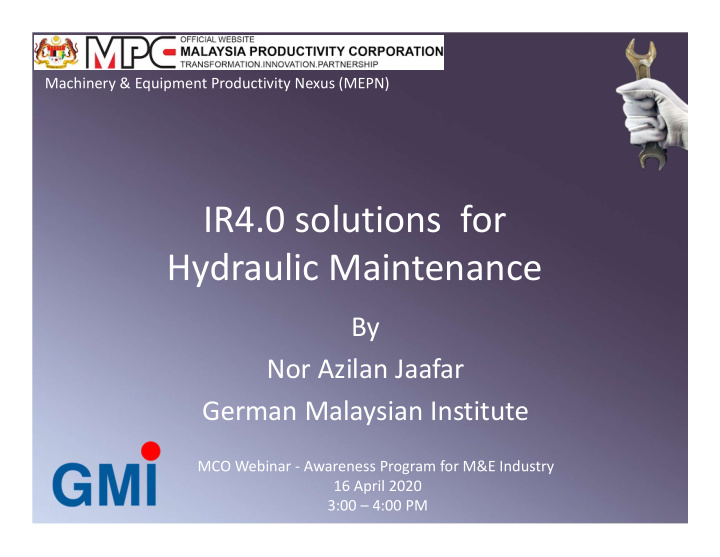



Machinery & Equipment Productivity Nexus (MEPN) IR4.0 solutions for Hydraulic Maintenance By Nor Azilan Jaafar German Malaysian Institute MCO Webinar - Awareness Program for M&E Industry 16 April 2020 3:00 – 4:00 PM
Introduction • Welcome to Maintenance Hydraulic with IR4.0 Solution • I will introduce on Hydraulic system conventional troubleshooting and maintenance and will share information how to use sensors as IoT data generation for better understand and enhance the operation of your hydraulic equipment.
Corrective Maintenance 2 01 Hydraulic Oil Level 02 Hydraulic Temperature & Odor 03 Hydraulic Oil Type ISO VG
Oil Level • One of the main issue in a hydraulic system is leakages. One drop of oil that drips once per second will lose 1500 litres a year. • This will effected the pump efficiency, malfunction and pressure drop, bubbles and air trap.
Level & Temperature Sensor with IoT RTD/PT100 Sensor Float Sensor Ultrasonic Sensor
Corrective Maintenance 2 04 Hydraulic Oil Filter 05 Hydraulic Pumps 06 Hydraulic Actuator and Seals
Filter with sensor indicator
Sensor on hydraulic pump with IoT
Linear position sensor + Linear Position Sensor Pressure Sensor
Corrective Maintenance 2 07 Electrical Control 08 Proportional Valve 09 Sensor interlock
Digital data from Electrical Panel to IoT
Oil Temperature • On any given hydraulic system, there should be some line that are hot (above 130 °C ), warm (100 – 130 °C) • This will effect the oil contamination (sludge & varnish), high viscosity, damaging the seals, fittings and actuators steels. The heat exchanger or cooling unit very important to control the oil temperature.
Oil Chiller The oil chiller is a unit which performs cooling of the hydraulic oil, lubricating oil and cooling oil of machine tools. In various parts of the machine tool spindles the bearings and gears get overheated and thermal deformation occurs due to the high speed rotational impact
Hydraulic Type ISO Standard (Grade/Code) Kinematic viscosity at 40°C ISO 3448 [mm 2 /s = cSt] Viscosity class Mid-point Minimum Maximum ISO VG 2 2.2 1.98 2.42 ISO VG 3 3.2 2.88 3.52 ISO VG 5 4.6 4.14 5.06 ISO VG 7 6.8 6.12 7.48 ISO VG 10 10 9.0 11.0 ISO VG 15 15 13.5 16.5 ISO VG 22 22 19.8 24.2 ISO VG 32 32 28.8 35.2 ISO VG 46 46 41.4 50.6 ISO VG 68 68 61.2 74.8 ISO VG 100 100* 90 110 ISO VG 150 150 135 165 ISO VG 220 220 198 242 ISO VG 320 320 288 352 ISO VG 460 460 414 506 ISO VG 680 680 612 748 ISO VG 1000 1000 900 1100 ISO VG 1500 1500 1350 1650
Oil Filter Stainless Fiber glass filter Mesh Micro Paper filter 1~20 um Steel filter Glass filter 1~10 um 25~80 um 5~40 um You should come across the following information to select the correct filter. 1. Beta rating 2. Type of the filter media 3. The filter’s model number and size Cellulose filter 4. Filtration efficiency 5-40 um Get advice from OEM / Manuals for different type of filter for Suction Filter, Pressure filter, Return Filter, Pilot Liner Pressure Filter & Offline Filter.
Hydraulic Pump Gear Type Rotary vane Screw type Bent Axis type type Axial type Radial type Throcoid type
Pump Diagnosis Through Case Drain
Axial Pump Vane Pump
Actuator Seals Type of seals in actuator 2 Piston Seal Bearing Rod Seal Rod Wiper Seal Get recommendation from machine manuals type of seals EPDM Silicone Viton (Synthehtic Nitrile Rubber)
Pressure Setting (Pressure Relief Valve) • One of the biggest problem in systems today is that the pressures are out of adjustment. • This problem will cause excessive force heat, leakage and wasted electrical energy.
Preventive Maintenance 2 Most companies make very few Preventive Maintenance checks such as; 01 02 03 04 05 06 BREATHER, PUMPS AND FILTER LEAKS SEAL AND OCCUMULATOR MOTOR OIL LEVEL CONDITION FITTINGS GASKETS , PRESSURE COUPLING RELIEF VALVE
Daily Maintenance Monitor 2 Check running Check oil Tighten Oil noise from contamination Screws/pipe Level pump odour coupling 1 3 5 7 2 4 6 8 Verify Check Oil Check Keep surface Pressure Temperature any pipe, pump, gauge Leaks valve and tank readings clean
+ 6 Weeks Maintenance 2 Check Replace Hydraulic Check fittings or actuators or hoses if or replace continue cylinders Filters leak 01 01 03 04 05 Clean Check and Strainer replace any leaking seal
+ 6 Months Maintenance 2 01 Send an oil sampling to check for viscosity /quality /contamination & wear . 01 Oil Sampling Test 02 Check the gas 02 Check pre-charge level Occumulators regularly. Check Check AC 03 the correct pre- Motor + charge Coupling Check 04 Pressure Relief Valve 03 Check AC motor 05 Check copling and AC Breather motor condition 04 Checking the maximum system pressure 05 Check any clogged filtered ,
Annual Maintenance 2 01 02 03 04 05 Dismantling Changing new Dismantling Cleaning Cleaning pump & Hydraulic Oil proportional reservoir tank diffuser and cleaning valve & & inlet buffle plate cleaning strainer reservoir cleaning .
CMMS
Predictive Maintenance PRESSURE SYSTEM FLOW TEMP OIL QUALITY VIBRATION TEST -PT100 / -Vibration -Oil sampling from -Pressure -High flow downstream point. Thermocou sensor -To find any sensor meter sensor ple sensor -detect daily correlation result. -detect daily -detect daily -detect daily vibration Contents of ; pressure oil flow. i. Ferrous temp. effect -recorded -recorded & ii. Particles - Recorded - Recorded iii. Nitrat and present present and present and present iv. Oxidation historical historical historical historical v. Potasium, data. data Sodium data data
Predictive Maintenance with CMMS and IoT
Output from Sensors present historical data (Example) EXAMPLE EXAMPLE EXAMPLE EXAMPLE
Continuous Oil Condition Monitoring
Conclusion 1
Recommend
More recommend